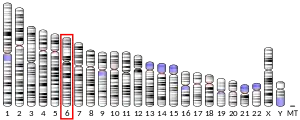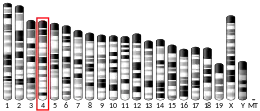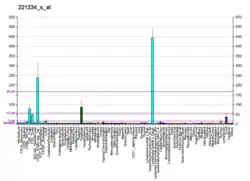Transcription regulator protein BACH2 (broad complex-tramtrack-bric a brac and Cap'n'collar homology 2) is a protein that in humans is encoded by the BACH2 gene.[5][6][7] It contains a BTB/POZ domain at its N-terminus which forms a disulphide-linked dimer [8] and a bZip_Maf domain at the C-terminus.
References
- 1 2 3 GRCh38: Ensembl release 89: ENSG00000112182 - Ensembl, May 2017
- 1 2 3 GRCm38: Ensembl release 89: ENSMUSG00000040270 - Ensembl, May 2017
- ↑ "Human PubMed Reference:". National Center for Biotechnology Information, U.S. National Library of Medicine.
- ↑ "Mouse PubMed Reference:". National Center for Biotechnology Information, U.S. National Library of Medicine.
- ↑ Sasaki S, Ito E, Toki T, Maekawa T, Kanezaki R, Umenai T, Muto A, Nagai H, Kinoshita T, Yamamoto M, Inazawa J, Taketo MM, Nakahata T, Igarashi K, Yokoyama M (August 2000). "Cloning and expression of human B cell-specific transcription factor BACH2 mapped to chromosome 6q15". Oncogene. 19 (33): 3739–49. doi:10.1038/sj.onc.1203716. PMID 10949928.
- ↑ Kamio T, Toki T, Kanezaki R, Sasaki S, Tandai S, Terui K, Ikebe D, Igarashi K, Ito E (November 2003). "B-cell-specific transcription factor BACH2 modifies the cytotoxic effects of anticancer drugs". Blood. 102 (9): 3317–22. doi:10.1182/blood-2002-12-3656. PMID 12829606.
- ↑ "Entrez Gene: BACH2 BTB and CNC homology 1, basic leucine zipper transcription factor 2".
- ↑ Rosbrook GO, Stead MA, Carr SB, Wright SC (January 2012). "The structure of the Bach2 POZ-domain dimer reveals an intersubunit disulfide bond" (PDF). Acta Crystallographica Section D. 68 (Pt 1): 26–34. doi:10.1107/S0907444911048335. PMID 22194330.
Further reading
- Oyake T, Itoh K, Motohashi H, Hayashi N, Hoshino H, Nishizawa M, Yamamoto M, Igarashi K (November 1996). "Bach proteins belong to a novel family of BTB-basic leucine zipper transcription factors that interact with MafK and regulate transcription through the NF-E2 site". Molecular and Cellular Biology. 16 (11): 6083–95. doi:10.1128/mcb.16.11.6083. PMC 231611. PMID 8887638.
- Kobayashi A, Yamagiwa H, Hoshino H, Muto A, Sato K, Morita M, Hayashi N, Yamamoto M, Igarashi K (March 2000). "A combinatorial code for gene expression generated by transcription factor Bach2 and MAZR (MAZ-related factor) through the BTB/POZ domain". Molecular and Cellular Biology. 20 (5): 1733–46. doi:10.1128/MCB.20.5.1733-1746.2000. PMC 85356. PMID 10669750.
- Hoshino H, Kobayashi A, Yoshida M, Kudo N, Oyake T, Motohashi H, Hayashi N, Yamamoto M, Igarashi K (May 2000). "Oxidative stress abolishes leptomycin B-sensitive nuclear export of transcription repressor Bach2 that counteracts activation of Maf recognition element". The Journal of Biological Chemistry. 275 (20): 15370–6. doi:10.1074/jbc.275.20.15370. PMID 10809773.
- Vieira SA, Deininger MW, Sorour A, Sinclair P, Foroni L, Goldman JM, Melo JV (December 2001). "Transcription factor BACH2 is transcriptionally regulated by the BCR/ABL oncogene". Genes, Chromosomes & Cancer. 32 (4): 353–63. doi:10.1002/gcc.1200. PMID 11746976. S2CID 21020332.
- Muto A, Tashiro S, Tsuchiya H, Kume A, Kanno M, Ito E, Yamamoto M, Igarashi K (June 2002). "Activation of Maf/AP-1 repressor Bach2 by oxidative stress promotes apoptosis and its interaction with promyelocytic leukemia nuclear bodies". The Journal of Biological Chemistry. 277 (23): 20724–33. doi:10.1074/jbc.M112003200. PMID 11923289.
- Takakuwa T, Luo WJ, Ham MF, Sakane-Ishikawa F, Wada N, Aozasa K (March 2004). "Integration of Epstein-Barr virus into chromosome 6q15 of Burkitt lymphoma cell line (Raji) induces loss of BACH2 expression". The American Journal of Pathology. 164 (3): 967–74. doi:10.1016/S0002-9440(10)63184-7. PMC 1614712. PMID 14982850.
- Tashiro S, Muto A, Tanimoto K, Tsuchiya H, Suzuki H, Hoshino H, Yoshida M, Walter J, Igarashi K (April 2004). "Repression of PML nuclear body-associated transcription by oxidative stress-activated Bach2". Molecular and Cellular Biology. 24 (8): 3473–84. doi:10.1128/MCB.24.8.3473-3484.2004. PMC 381671. PMID 15060166.
- Motamed-Khorasani A, Jurisica I, Letarte M, Shaw PA, Parkes RK, Zhang X, Evangelou A, Rosen B, Murphy KJ, Brown TJ (January 2007). "Differentially androgen-modulated genes in ovarian epithelial cells from BRCA mutation carriers and control patients predict ovarian cancer survival and disease progression". Oncogene. 26 (2): 198–214. doi:10.1038/sj.onc.1209773. PMID 16832351. S2CID 23262017.
- Yoshida C, Yoshida F, Sears DE, Hart SM, Ikebe D, Muto A, Basu S, Igarashi K, Melo JV (February 2007). "Bcr-Abl signaling through the PI-3/S6 kinase pathway inhibits nuclear translocation of the transcription factor Bach2, which represses the antiapoptotic factor heme oxygenase-1". Blood. 109 (3): 1211–9. doi:10.1182/blood-2005-12-040972. PMID 17018862. S2CID 10475263.
- Ono A, Kono K, Ikebe D, Muto A, Sun J, Kobayashi M, Ueda K, Melo JV, Igarashi K, Tashiro S (January 2007). "Nuclear positioning of the BACH2 gene in BCR-ABL positive leukemic cells". Genes, Chromosomes & Cancer. 46 (1): 67–74. doi:10.1002/gcc.20390. PMID 17044046. S2CID 13276741.
- Ikeda T, Shibata J, Yoshimura K, Koito A, Matsushita S (March 2007). "Recurrent HIV-1 integration at the BACH2 locus in resting CD4+ T cell populations during effective highly active antiretroviral therapy". The Journal of Infectious Diseases. 195 (5): 716–25. doi:10.1086/510915. PMID 17262715.
- Hoshino H, Nishino TG, Tashiro S, Miyazaki M, Ohmiya Y, Igarashi K, Horinouchi S, Yoshida M (May 2007). "Co-repressor SMRT and class II histone deacetylases promote Bach2 nuclear retention and formation of nuclear foci that are responsible for local transcriptional repression". Journal of Biochemistry. 141 (5): 719–27. CiteSeerX 10.1.1.326.4123. doi:10.1093/jb/mvm073. PMID 17383980.
External links
- BACH2+protein,+human at the U.S. National Library of Medicine Medical Subject Headings (MeSH)
- Human BACH2 genome location and BACH2 gene details page in the UCSC Genome Browser.
- Overview of all the structural information available in the PDB for UniProt: Q9BYV9 (Transcription regulator protein BACH2) at the PDBe-KB.
This article incorporates text from the United States National Library of Medicine, which is in the public domain.
This article is issued from Wikipedia. The text is licensed under Creative Commons - Attribution - Sharealike. Additional terms may apply for the media files.





